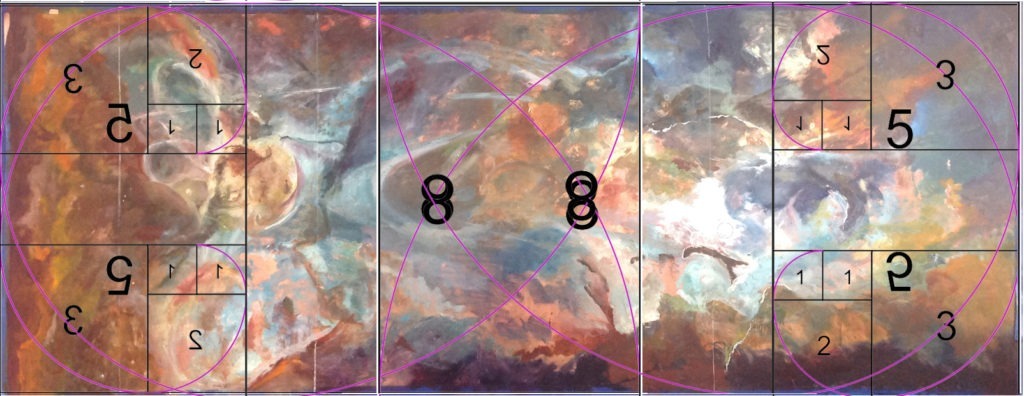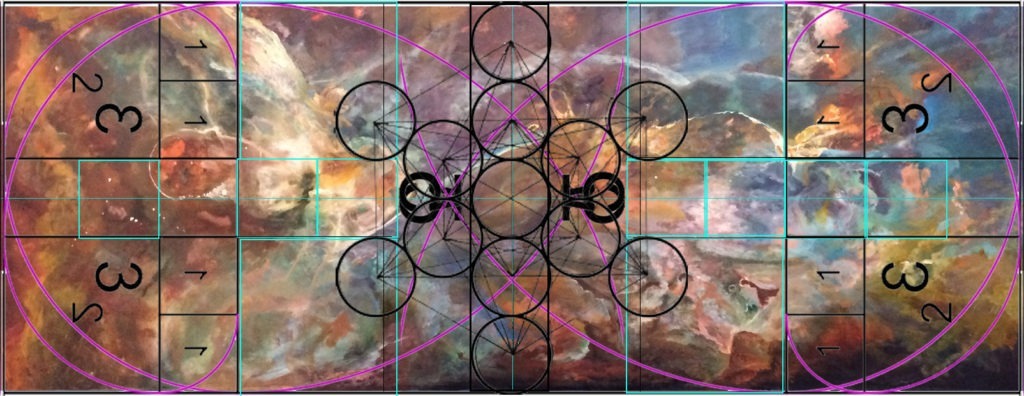Phi: Infinity, Unity, beauty and the Divine Feminine
One cannot paint the universe without feeling the divine nature within.
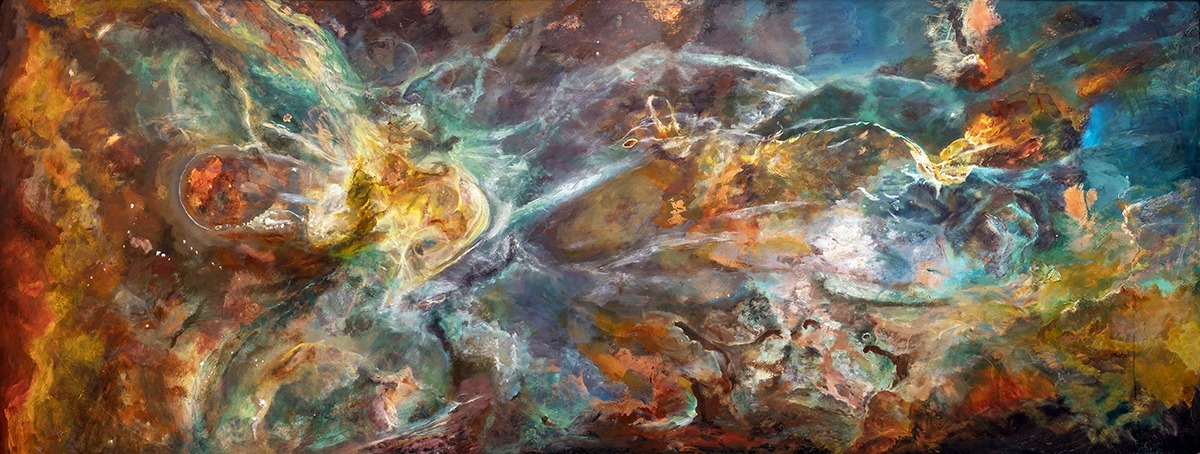
The full-scale print of the painting ‘Phi’ is now installed in the Vatican Observatory Museum. The museum is mainly dedicated to historical astronomical instruments and other artifacts. However, one special room directly below the Schmidt telescope is being dedicated to astronomical art. Along with ‘Phi’ is an 18th-century marble sculpture of the solar system (artist unknown), currently in restoration at the Vatican; an original painting by noted astronomical artist Ron Miller; and a spectacular sculpture “Rotazione Apparente” by Marco Bagnoli, along with particularly important astronomical images by Specola astronomers using telescopes from around the world. A print of my painting “Juno” named after the Roman Goddess of fertility and the Jovian probe is also in the Vatican Observatory Museum’s permanent collection.
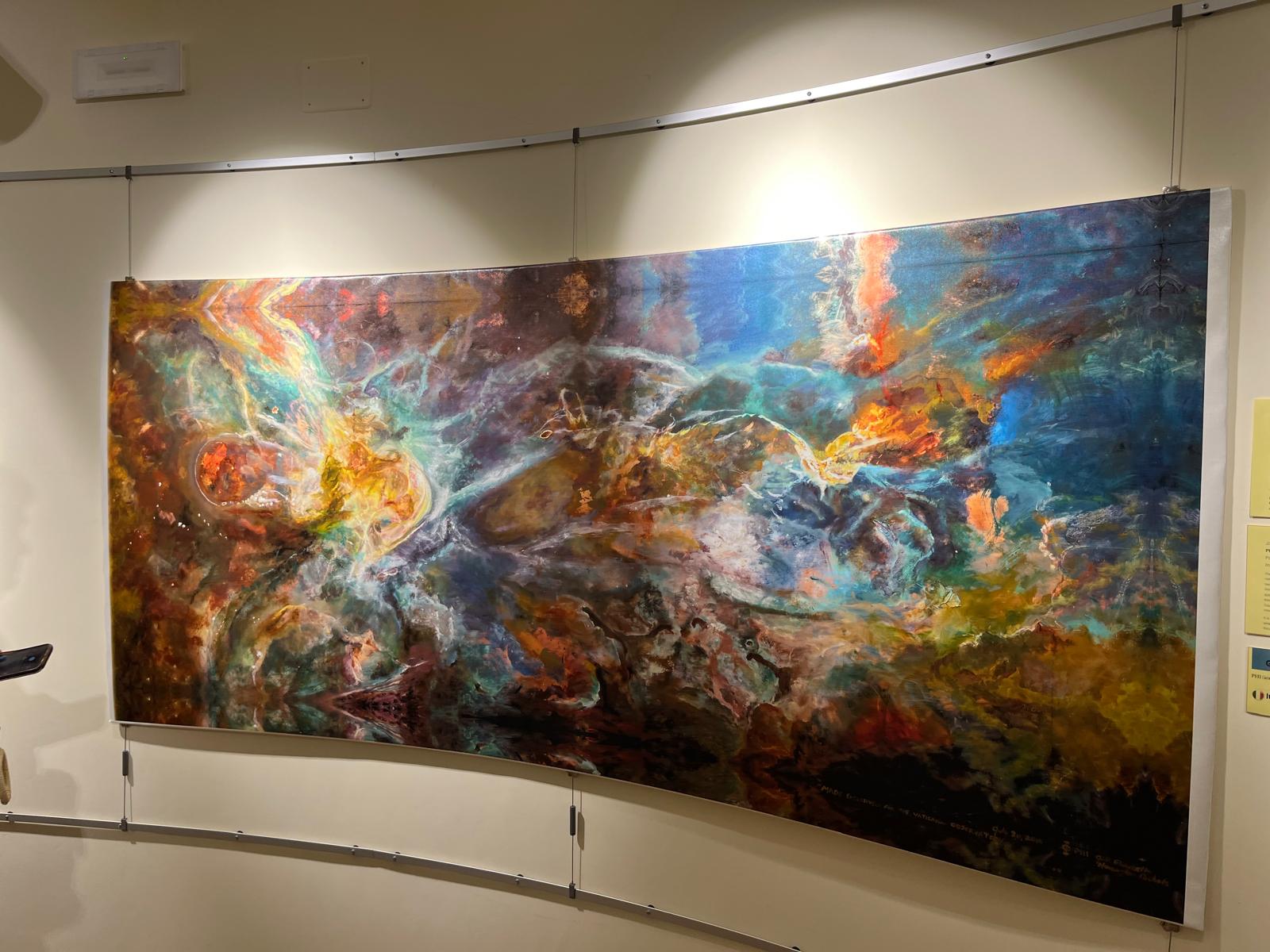
Divine Cosmos: Art with a Specola Connection
“Phi [ϕ]” spirals us to infinity beyond and within. Inspired by the Carina Nebula, we are brought to the inner chambers of the heart; light and energy generated millions of years ago, breaking through the shadows and darkness of outer and inner space. Painted on copper with hand-mixed paints formulated with mica and other earthbound stardust.
Named for the Greek letter, Phi signifies the mathematical golden ratio 1.618 – Unity – nothingness and everything, pure beauty. The painting began with the discovery of a piece of scrap copper, 8 by 3 feet which lent itself perfectly to the copper and verdigris dominant colors in the Hubble Space Telescope image of the Carina Nebula.
While painting the heavenly body, I felt the presence of Spirit draw near. Under my brush, the shape of a heart (toward the left), emerged from the starlit gases. Unbidden, Jill was struck with the sense that this was Mother Mary’s universal loving and healing heart. Pulsing from the heart, electromagnetic energy dispersed into arcs across the painting. These arcs took the form of a dove (toward the right), the symbol of The Holy Spirit, which the artist sensed as a peaceful feminine presence full of wisdom and grace. The notions that the Mother Mary and The Holy Spirit were embodied in the painting prompted Jill to question the significance of the Divine Feminine. She discovered that in ancient Christianity and Judaism the Holy Spirit had once been feminine; Sophia the Wife of God, and part of the Trinity. This implies that the true nature of the Divine Feminine has been lost through the millennium. The creation stories of most cultures refer to Earth as mother and the heavens as father. This suggests that there was an irrevocable split between the feminine and masculine, rather than allowing for a more balanced unifying belief that both are essential, equal, and one. While it’s true that earth is life-giving, so too are the nebulas.
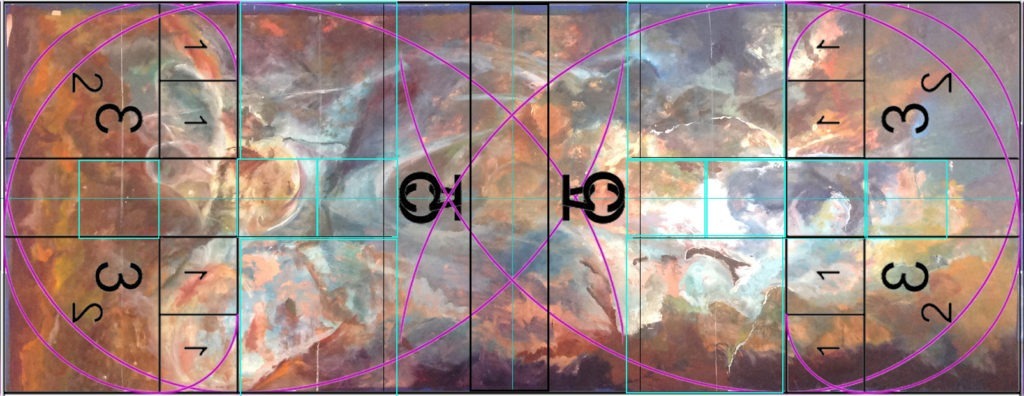
Early in the painting process, I realized that the dimensions of the scrap metal were not in proportion to the Hubble image. I applied overlays of the Fibonacci sequence and then mapped the resulting grid onto the painting to inform her of how to adjust the composition to more faithfully represent the proportions and positions in the telescope image. In addition, superimposing the Fibonacci sequence divided the painting into equal units of “1”, with a remainder of a nearly perfect golden ratio proportioned rectangle. This rectangle was dead center in the grid, unintentionally creating three crosses (cyan and black boxes) across the width of the painting. This prompted me to consider that in essence, this was a modern-day crucifixion painting. And that the center of the painting is ‘God’, as infinity.

Photos Left to right: Jill standing in space where ‘Phi’ will be installed, Pope Paul VI broadcasts blessings to Apollo 11 astronauts in 1969, Director Brother Guy Consolmagno’s finger points to the location of the lunar landing on the moon while showing me an illustration from the late 1700’s of the moon and its craters, the Vatican Observatory, Brother Guy and I holding up ‘Phi’ in its new home in the Vatican Observatory Museum, a slot of space streaming through the observatory’s all wood dome, Jill standing where Pope Paul VI broadcasted to the men on the moon 50 years to the day, Jill under the telescope, Vatican Specula entry.
Update July 20, 2019: I delivered a full-scale print of ‘Phi’ to Brother Guy Consolmagno, Director of the Vatican Observatory to be installed at the Vatican Observatory Museum, Castel Gandolfo, Vatican City. The Vatican Observatory Museum is open to the public.
We drove in his oversized blue car, inherited from the previous Director, through the Papal Gardens to the Observatory. (Brother Guy would prefer a much smaller car that would be easier to negotiate the roads that look more like walkways.) He gave me a wonderful tour of the entire Vatican Observatory offices and the Observatory itself which includes two different types of telescopes. It was amazing to realize that I was standing in the spot where exactly 50 years prior the Pope had broadcasted on TV, a then relatively new medium, a blessing to the first men that landed on the moon. Brother Guy opened the all-wooden Dome (with controls that made him look like the Great Wizard of Oz), allowing for some of the brilliant Italian sunlight to enter the otherwise dark dome.
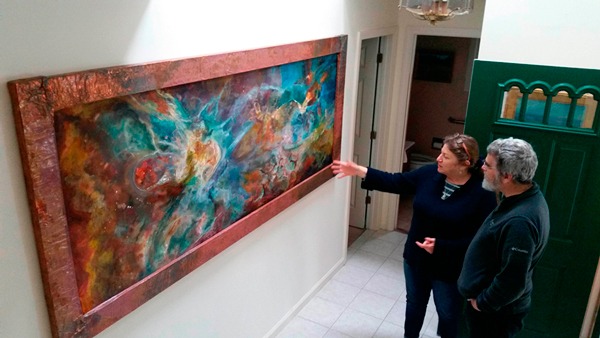
visits Jill and her painting, Phi in her home studio.
Phi, based on the Carina Nebula, speaks to the Unity found through the Divine Feminine.
Juno, also installed in the Vatican Observatory, named after the Fertility Goddess and the probe. READ MORE
I was first introduced to Brother Guy via email through his colleague and mutual friend Leslie Schaffer. When I first reached out to Brother Guy I had asked him if he could think of a place where I might display ‘Phi’. He responded that he couldn’t think of any better place than the Vatican Observatory. Whichever you want to call it – serendipity, divine plan or just sheer luck brought Brother Guy near my hometown for a commencement speech at Fairfield University in May 2018. At this time he made the effort to visit ‘Phi’ in person. My studio/gallery was cleaned in anticipation of his arrival with the help of my sister, Les, and two sons. Les helped me bake a French toast recipe that neither of us had ever made before. After all the preparation the studio looked immaculate until just at the time of Brother Guy’s anticipated arrival the maple syrup overflowed on the burners in the oven and filled the house with white smoke. I had to laugh and think of the white smoke used to declare the newly elected Pope. Fortunately, Brother Guy is extremely gracious, humble, and for a scientist with his mind in the stars, quite down to earth.
Below you will find the revised* blog that I wrote about the painting upon its completion – posted on the first of the year in 2017…This painting started as an exploration of the Carina Nebula. It became about Sensing the Divine while being transported 10,000 light-years with quantum entanglement…
Day 01 01, the start of a new circle around the sun through the space-time continuum.
“Phi [ϕ]”, spirals us to infinity beyond and within. Based on the Carina Nebula, we are brought to the inner chambers of the heart; light and energy generated millions of years ago, breaking through the shadows and darkness of outer and inner space. Painted on copper with hand-mixed paints formulated with mica, copper, and other earthbound stardust.
Named after the Greek alphabet, Phi represents the mathematical golden ratio 1.618/Unity – oneness, nothingness, and everything at once, pure beauty.
The painting began with a gorgeous piece of scrap copper 8′ in length by 3′ wide. My colleagues suggested that I cut the copper into smaller pieces to create more reasonably sized paintings that would sell.
I had my eye set on larger things, the universe to be precise. Specifically, the Carina Nebula as imaged from the Hubble Telescope**.
One cannot paint the universe without feeling the divine nature within.
As I painted the heavenly body I felt the presence of Spirit and God*** draw near while at work as well as during the course of my day-to-day life.
My only intention when I had set out was to paint a nebula. I am merely sharing my experiences over the last six months, all of which seem to be a part of the journey of ‘Phi’. I ask that you take what you please and leave the rest.
For many years as an adult woman, I had experienced a spiritual void. The root of this was that I am a woman in a man’s world. More to the point in a man’s religion. All the focus has been on the ‘male’ God, “Father” and “Son” Jesus. Even in exploring my Jewish heritage, there was the “male” God.
There was no place for me. Out of place, I felt abandoned, coerced into a faith where I didn’t belong. In talking with other females I’ve grown to understand that I am not alone in this feeling. Out of desperation, I began to ask God “Why?’ and as a female how am to I follow a God that doesn’t represent me? After all, we were all created in ‘his image’ or are we to believe that females are created from the rib of a man, a genetic mutation, divine cloning with a kick?
Sometimes when we ask we get answers.
Nebula gases and light/energy took on shapes under the brush
In late summer, I received a text about the condition of a dear friend’s heart. The text came in just as I was viewing a painting of the Mother Mary pierced with seven protruding blades in an antique shop. I had never seen this image. I came to know that this is called the Immaculate Heart and represents the seven wounds or swords of Mary.
As I painted I could feel the pulse of electro-magnetic energy as it pumped through the chambers of the heart dispersing it into arcs, which took on the shape of a dove at the right. Struck by the notion that this painting embraced light and energy and the divine feminine, specifically that of the heart of Mother Mary and the female Holy Spirit, the Dove Sophia. ^
By overlaying the spirals I found that the center of the composition became Infinity – Unity
Experimenting with colors and ways of applying the paint and revealing areas of copper with steel wool, I painted in the basic composition and then scanned it into Photoshop. Creating overlays on the preliminary image I began my search for Phi, the golden ratio(s), and the Fibonacci Sequence Spirals within the composition. I realized that if I put a square at either side I wound up with a near-perfect golden ratio rectangle dead center. In making a grid across the center lines I discovered three crosses. I also found that the seed of life perfectly overlaid the ‘cross’/’unity’ center.
Clarity on a day in October while visiting New York City.
Shortly after I had created the grid in Photoshop I made a trip into New York City. In the morning I received a text from my sister. She had found at her feet, while in church, the program from the Easter service two years prior. This was her first return to that church after we had attended the Palm Sunday service together that same year.
That afternoon I walked up to the Guggenheim and viewed the works of Agnes Martin, “Beauty and Truth”. Martin’s abstract grids represented concepts. Her work reminded me of the grids that I had just created, specifically the three crosses representing the crucifixion.
A sea of purple paraded through Times Square, with a Crucifix held high in the air.
On my walk from the Guggenheim to the train I saw hundreds of people marching in the streets. Asking several people in the parade what it was all about a few shook their heads. They could not understand my question. Finally, one woman, in broken English said, “It’s the miracles”. Still not clear of its meaning I did some research.
The miracles refer to the painting, Señor de los Milagros, a Crucifixion painting. Painted by a slave from Angola in colonial Lima, Peru. At the top is the Dove/Holy Spirit and God the Father. Below and to the right of Jesus is the Virgin Mary with her heart pierced by the sword of sorrows.
Señor de los Milagros. became known as a miracle because it survived two earthquakes and the intended destruction by the Catholic church. Every year in October, hundreds of thousands of devotees participate in a religious procession honoring the image through the streets of Lima, Peru. Each Sunday in October followers march in the streets of New York City.
Rembrandt etchings
In November, after a lecture by John Walsh at the Yale Art Gallery, I was privileged to view some Rembrandt etchings. One etching depicted the scripture from the Easter program that my sister had found, Christ at Emmaus, Luke 24:31, “Then their eyes were opened and they recognized him, and he disappeared from their sight.” A reference to the resurrection of Jesus and how he first appeared to women.
And so I wonder, is this a modern-day crucifixion painting, a thing of beauty, a reverence to science?
Adding the last strokes in December, I completed the painting, just before Christmas. Transforming my studio back into a bedroom for my sons’ visit.
The message seemed clear to me- that is time that we all embrace the Divine Feminine. By incorporating the Divine Feminine we can start to balance and heal ourselves, (man)kind, and the planet.
There is still a lot to share and say. I’m still working on writing it all down. Please check back periodically as I will continue to update. Thank you for sharing in my journey with ‘Phi’.
Wishing you a year full of unity, of pure beauty!
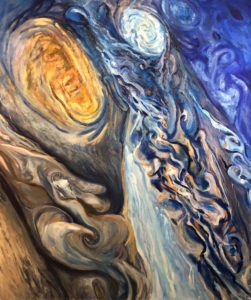
Prints of Jill’s paintings “Phi” and “Juno” are now included in the collection of the Vatican Observatory Museum. The museum is mainly dedicated to historical astronomical instruments and other artifacts. However, one special room directly below the Schmidt telescope is being dedicated to astronomical art.
